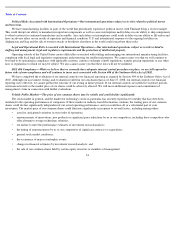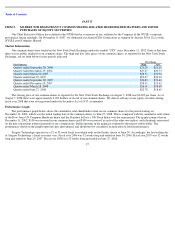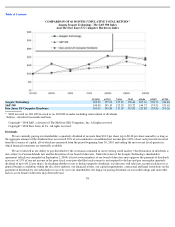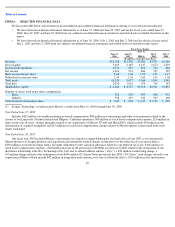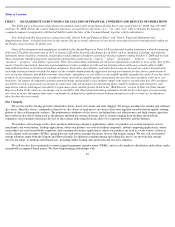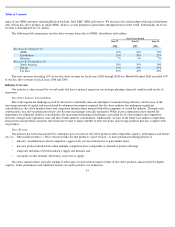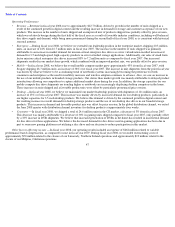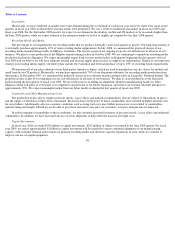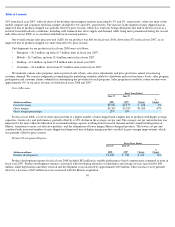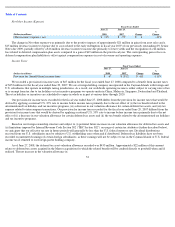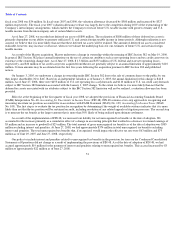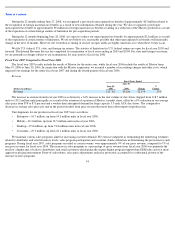Seagate 2007 Annual Report Download - page 45
Download and view the complete annual report
Please find page 45 of the 2007 Seagate annual report below. You can navigate through the pages in the report by either clicking on the pages listed below, or by using the keyword search tool below to find specific information within the annual report.
Table of Contents
We expect price erosion in our industry will continue for the foreseeable future. To remain competitive, we believe it will be necessary to
continue to reduce prices as well as introduce new product offerings that utilize advanced technologies ahead of our competitors in order to take
advantage of potentially higher initial profit margins and reduced cost structure on these new products.
Disc Drive Industry Demand Trends
We believe that the disc drive industry is experiencing the following demand trends:
We believe that technological advances in storage technology and a proliferation of non-compute applications is increasingly driving the
broad, global proliferation of digital content through the creation, sharing, aggregation, distribution, consumption and protection of all types of
digital content. We believe that growth in digital content is being driven by increases in media-rich as well as user generated content, the
digitization of content previously stored in analog format and the duplication of content in multiple locations. As a result of these factors, the
nature and amount of content being created requires increasingly higher storage capacity in order to store, manage, distribute, back up and use
such content.
We believe that demand for electronic data storage in the enterprise and traditional compute markets continues to grow as increasing legal
and regulatory requirements and changes in the nature and amount of data being stored has necessitated additional storage. Additionally, the
proliferation of digital content in the consumer space has resulted in additional demand for storage by enterprises, including those that host,
aggregate, distribute or share such content.
•
Disc Drives for Mobile Computing.
The mobile computing market is growing faster than the market for desktop computers as price
and performance continue to improve. Notebook systems are increasingly becoming the preference for both consumers and enterprises
as the need for mobility increases and wireless adoption continues to advance. We estimate that in fiscal year 2008, industry shipments
of disc drives for mobile compute applications grew approximately 45% from fiscal year 2007.
The disc drive industry has recently seen the introduction of alternative technologies that directly compete with mobile disc drives. For
example, certain manufacturers have introduced solid state drives (SSDs), using flash memory technology, which is an alternative to
disc drives in certain applications. Due to the high capital requirements and capacity required to manufacture flash memory, we
believe the perceived benefits of SSDs are not currently realized at an attractive cost relative to hard disc drives, particularly in higher
capacity applications. We believe that the market for these alternative technologies is still developing and because of the current high
cost per gigabyte of these storage solutions, we do not expect these solutions to have a significant near-term impact on the overall
market for disc drives for mobile computing.
•
Disc Drives for Enterprise Storage.
The need to address the expansion in data storage management requirements has increased the
demand for new hardware storage solutions for both mission critical and business critical enterprise storage.
Mission critical enterprise storage is defined by the use of high performance, high capacity disc drives for use in applications which
are vital to the operation of enterprises. We expect the market for mission critical enterprise storage solutions to grow, driven by many
enterprises continuing to move network traffic to dedicated storage area networks (SANs). In addition, many enterprises are moving
away from the use of server-attached storage to network-attached storage (NAS). Both of these solutions are comprised principally of
high performance, high capacity disc drives with sophisticated software and communications technologies. In addition, many
enterprises are also consolidating data centers, aiming to increase speed and reliability within a smaller space, reducing network
complexity and increasing energy savings, which has led to an increased demand for more energy efficient, small form factor disc
drives. SSD storage applications have been introduced as a potential alternative to redundant system
44


